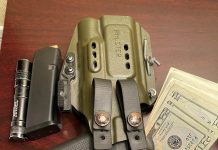Imagine stumbling across a nice, 3-inch stainless steel Ruger GP100 in a gun store back in the early 2000s. The gun looks great, and there on the left side of the frame is a mysterious stamp: “CIA, Georgia VT.” Those three letters, “CIA,” immediately send the mind on a tour of fantasy, wondering if this gun was in the hands of an agent creeping around Central America? No, as CIA in this case stands for Century International Arms, the company that re-imported these guns. That doesn’t make these imported Ruger GP100s any less interesting, though.
During the mid 1980s and into the early 1990s, Ruger produced GP100 revolvers specifically for the export market. The two biggest consumers of these guns were Canada and France. In Canada, they were issued to the RCMP and municipal agencies, including the Montreal police department. In France, they were also issued to municipal police forces, sometimes alongside the Manurhin MR88, and sometimes instead of the French manufactured revolver. Eventually, they have been retired or phased out of service, and these imported Ruger GP100s have returned to the United States.
Now that they’re back, the imported Ruger GP100s make great basic carry guns, fun range guns, or first revolvers. Before the COVID-19 pandemic, they could be found for $300-$350 from surplus websites or on Gunbroker, and will hopefully return to around that price once the world settles down. If you do get a chance to inspect one before you buy, check three areas before you slap your cash on the glass. The first thing to check for is lockup – when the hammer is forward and the trigger to the rear, the cylinder should not have excessive side-to-side movement. A little wiggle is okay, but you shouldn’t be able to move the cylinder hole opening past the forcing cone. Next, on a GP100 you want to make sure the trigger/hammer engagement is working correctly by decocking the revolver. Cock the gun, then ease the hammer forward while releasing the trigger. The trigger should rebound forward on its own. Last, take the grips off and check for rust under them.
If you happen to have a set of feeler gauges and know what you’re doing, you could also check one of these imported Ruger GP100s for endshake, which is the amount of forward and backward cylinder movement. Truth be told, most of these foreign trade-ins have been shot minimally, so endshake won’t be an issue. I had a GP100 that fired over 10,000 rounds of 38 Special and never developed significant endshake, so a cop gun should be fine.
These imported Ruger GP100s are a great choice for a first revolver or a carry gun, if you can find one for a reasonable price. They’re fun guns with a good story, and they’re also some of the last law enforcement trade-in revolvers out there. If you see one, grab it!
During the mid 1980s and into the early 1990s, Ruger produced GP100 revolvers specifically for the export market. The two biggest consumers of these guns were Canada and France. In Canada, they were issued to the RCMP and municipal agencies, including the Montreal police department. In France, they were also issued to municipal police forces, sometimes alongside the Manurhin MR88, and sometimes instead of the French manufactured revolver. Eventually, they have been retired or phased out of service, and these imported GP100s have returned to the United States.
Now that they’re back, the imported Ruger GP100s make great basic carry guns, fun range guns, or first revolvers. Before the COVID-19 pandemic, they could be found for $300-$350 from surplus websites or on Gunbroker, and will hopefully return to around that price once the world settles down. If you do get a chance to inspect one before you buy, check three areas before you slap your cash on the glass. The first thing to check for is lockup – when the hammer is forward and the trigger to the rear, the cylinder should not have excessive side-to-side movement. A little wiggle is okay, but you shouldn’t be able to move the cylinder hole opening past the forcing cone. Next, on a GP100 you want to make sure the trigger/hammer engagement is working correctly by decocking the revolver. Cock the gun, then ease the hammer forward while releasing the trigger. The trigger should rebound forward on its own. Last, take the grips off and check for rust under them.
If you happen to have a set of feeler gauges and know what you’re doing, you could also check one of these imported GP100s for endshake, which is the amount of forward and backward cylinder movement. Truth be told, most of these foreign trade-ins have been shot minimally, so endshake won’t be an issue. I had a GP100 that fired over 10,000 rounds of 38 Special and never developed significant endshake, so a cop gun should be fine.
These imported GP100s are a great choice for a first revolver or a carry gun, if you can find one for a reasonable price. They’re fun guns with a good story, and they’re also some of the last law enforcement trade-in revolvers out there. If you see one, grab it!



